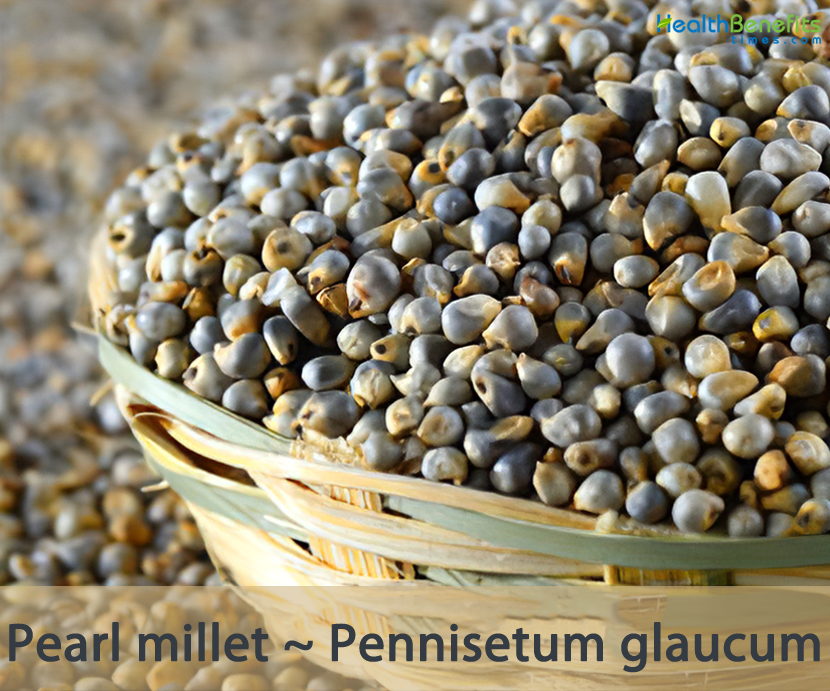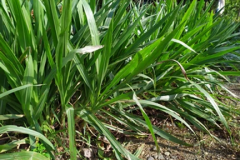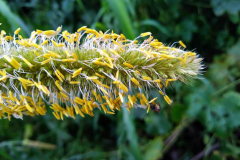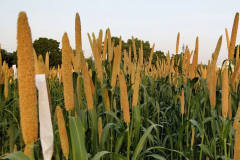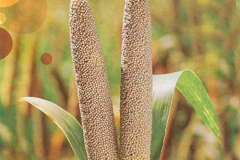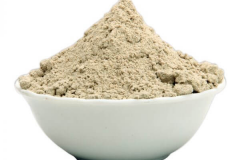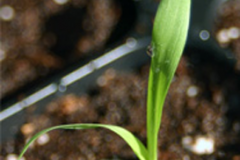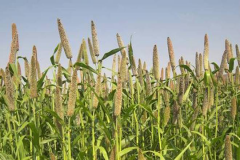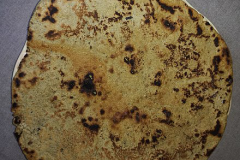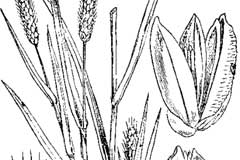| Pearl millet Quick Facts | |
|---|---|
| Name: | Pearl millet |
| Scientific Name: | Pennisetum glaucum |
| Origin | Across Africa from West to East, and from there to Southern Africa |
| Colors | White, pearl-colored or yellow to grey-blue or brown, occasionally purple |
| Shapes | Globose to cylindrical or conical grains, 2.5–6.5 mm long |
| Taste | Sweet |
| Health benefits | Improve immune function, Prevents cancer, Prevents celiac disease, Improves muscle mass, Promotes Heart Health, Treats Iron Deficiency Anemia, Reduces Cholesterol, Promotes digestive health, Manages diabetes, Promotes weight loss, Relieves Constipation, Provides Energy, Preventing gallstones, Polycystic Ovarian Syndrome, Boosts Lung Power, Combats Acidity, Pregnancy Food, Strengthens Bones, Improves Eyesight, Beats Fatigue, Prevents gluten sensitivity, Skin and Hair Health |
| Name | Pearl millet |
|---|---|
| Scientific Name | Pennisetum glaucum |
| Native | Across Africa from West to East, and from there to Southern Africa. It was introduced to India in 3000 BC and later to America, Brazil and Australia |
| Common Names | Bulrush millet, burr bristle grass, cat’s tail grass, cattail millet, mongoose tail grass, pale pigeongrass, pearl millet, yellow bristle grass, yellow foxtail, poko grass, Indian millet, Bajra, Horse millet, African millet, Candle millet, Short millet |
| Name in Other Languages | Afrikaans: Pêrel gierst, Babala Albanian: Meli margaritar Amharic: lrili mashila (lርል ማሽላ) Arabic: Aldukhn alluwlu (الدخن اللؤلؤ), Duhun, Dukhon Armenian: Margarit korek (մարգարիտ կորեկ) Azerbaijani: Inci darı Bemba: Mpyoli Bengali: Muktā bājarā (মুক্তা বাজরা), bajara (বাজরা) Bulgarian: Perleno proso (перлено просо), sivosinkava koshtryava (сивосинкава кощрява) Burmese: Pulell millet Catalan: Xereix d’aresta groga Chinese: Zhēnzhū sù (珍珠粟), Jin se gou wei cao, Yu gu (御谷), La zhu bai Croatian: Biserno proso Czech: Perlová proso Danish: Perle hirse, Negerhirse Dutch: Negergierst , Parelgierst, Zeegroene naaldaar English: Pearl millet, Indian millet, Bajra, Bulrush millet, Cattail millet, Horse millet, Yellow bristlegrass, Pale pigeon grass, African millet, Candle millet, Yellow fox tail, Short millet, bulrush millet, pokograss Esperanto: Perla mijo Estonian: Pärli hirss, Vesihaljas kukeleib Filipino: Perlas millet Finnish: Helmi hirssi, Helmisulkahirssi French: Mil perlé, Mil africain, Millet perle, Millet à chandelles, Millet à chandelle, Millet pénicillaire, Pénicillaire, Mil à chandelle, Millet africain, Millet d’Afrique, Sétaire glauque, petit mil, mil, millet perle Georgian: Margalit’is pet’vi (მარგალიტის ფეტვი) German: Perlhirse, Negerhirse, Rohrkolbenhirse, Pinselgras, Gilb Fennich, gelbe Perlhirse, Fuchsrote Borstenhirse, Gelbe Borstenhirse, Gelbe Borstenhirse, Graugruene Borstenhirse, Niedrige Borstenhirse, Perlhirse, Rohrkolbenhirse Greek: Kechrí margaritarión (κεχρί μαργαριταριών), Amerikaniko kechri (Αµερικάνικο κεχρί), Kechri (Κεχρί), Kechri glaukochromi (Κεχρί γλαυκόχρωμη), Setaria glaukochromi (Σετάρια γλαυκόχρωμη) Gujarati: Mōtī bājarī (મોતી બાજરી), Bājarō (બાજરો),nbajari (બાજરી) Hausa: Gero mai lu’u-lu’u, Gero Hebrew: דוחן פנינים Hindi: Baajara (बाजरा), Bajra, Kolvi, Kolhu, laharra (लहर्रा) Hungarian: Gyöngy köles, Négerköles Icelandic: Perlu hirsi Indonesian: Millet mutiara Irish: Muiléad péarla Italian: Miglio africano, Miglio perla, Miglio perlato, miglio de l’India, miglio perlato; panicastrella scura; panico glauco; pesarone Japanese: Pārumiretto (パールミレット), Toujin kibi, Kin enokoro, Tôjin bie (トウジンビエ), Tôjin hie Javanese: Millet mutiara Kannada: Muttu rāgi (ಮುತ್ತು ರಾಗಿ), sajje (ಸಜ್ಜೆ) Kazakh: Injw tarı (інжу тары) Kikuyu: Mwere Konkani: Bajari (बाजरी) Korean: Jinju gijang (진주 기장) Kurdish: Melleya pez Lao: Muk muk (ມຸກມຸກ) Latin: Margarita milium Latvian: Pērļu prosa Lithuanian: Perlų soros Macedonian: Biser proso (бисер просо) Malagasy: Millet millet Malay: Mutiara mutiara Malayalam: Mutt millaṟṟ (മുത്ത് മില്ലറ്റ്), kanpari (കന്പരി) Maltese: Millieġ tal-perla Marathi: Mōtī bājarī (मोती बाजरी), bajari (बाजरी), sajagura (सजगुरा) Mongolian: Suvdan shar budaa (сувдан шар будаа) Nepali: Motee kore (मोती कोरे), Baajaraa, bajuro (बाजुरो) Netherlands: Zeegroene Naaldaar Norwegian: Perle hirse Occitan: Cua de vop, herbo de tal, làye, milhauco, mouséne, payen, pà d’auset Oriya: ମୋତି ମିଲେଟ, ବାଜରା bajara Pashto: د جوارو جوار Persian: ارزن مروارید Polish: Proso perłowe, Rosplenica sina Portuguese: Milheto, Milhete, Milho africano, Milho miúdo, Painço, Peniseto, Bajra, Mexoeira, milheto-pérola, milhã-amarelha, capim-tinga; milha-amarelada; milha-paiceira Punjabi: Mōtī bājarē (ਮੋਤੀ ਬਾਜਰੇ), bajra (ਬਾਜਰਾ) Romanian: Perla mei Russia: zhemchuzhnoye proso (жемчужное просо), Proso afrikanskoe (Просо африканское), Proso amerikanskoe (Просо американское), pennisetum sizyy (пеннисетум сизый), shchetinnik sizyy (щетинник сизый) Serbian: Biserno proso (бисерно просо) Sindhi: Muti jiwar (موتي جوار) Sinhala: Mutu menēri (මුතු මෙනේරි) Slovenian: Biserno proso Spanish: Mijo negro, Mijo perla, Mijo candela, Panizo negro, Pasto italiano, almorejo glauco, cola de zorra amarilla, hopillo, limpio frasco, rabo de zorro, bajra, mijo perla, panizo de Daimiel, panizo mamoso, legartera, panizo negro, Helmisulkahirssi, cusanillo, mijo perla Sundanese: Mutiara mutiara Swahili: Mawele, Uwele Swedish: Pärla hirs, Pärlhirs, graa Kolvhirs Tajik: арзан марворид-arzan marvorid Tamil: முத்து தினை-Muttu tiṉai, இளங்கம்பு ilan-kampu Telugu: పెర్ల్ మిల్లెట్-Perl milleṭ, గంచెలు gantelu Thai: ลูกเดือยไข่มุก-Lūk deụ̄xy k̄hị̀muk, Khao fang nok Tongan: Tetefa Turkish: Inci darı Ukrainian: перлове пшоно-perlove pshono, пенісетум американський Urdu: موتی باجرا Uzbek: Marvarid tariq Vietnamese: Ngọc trai kê, Lua miêu, cor duooi voi; kee voi; lus a mieeu Welsh: Miled perlog Yoruba: Emeye Zulu: Pearl millet, Amabele, Unyaluthi, Unyawoti, Unyawothi |
| Plant Growth Habit | Annual, erect, warm-season bunch grass |
| Growing Climates | Along roadsides and tracks, in cultivated areas such as rice fields, on dry open hillsides and open rocky places, in swampy areas, and on the inner edges of mangrove swamps, waste places and river banks in sandy soils |
| Soil | Best adapted to sandy or light loams and moist but well-drained soils. It has good tolerance to drought |
| Plant Size | Up to 10 feet tall and 3 feet wide |
| Root | Extensive root system |
| Stem | Upright stems can reach up to 1/2–1 inch diameter and have a dense covering of hairs at their nodes |
| Leaf | Alternate and simple. Leaf sheath is often hairy; ligule or junction is short, membranous, with a fringe of hairs 0.08–0.1 inch long. Blades are linear to linear-lanceolate, up to 1.5 m long and 8 cm wide and often pubescent. |
| Flowering season | September to October |
| Flower | Inflorescence a cylindrical, contracted, stiff and compact panicle, suggesting a spike, up to 200 cm long; rachis cylindrical, bearing densely packed clusters of 5-9 spikelets |
| Fruit Shape & Size | Globose to cylindrical or conical grains, 2.5–6.5 mm long |
| Fruit Color | White, pearl-coloured or yellow to grey-blue or brown, occasionally purple |
| Taste | Sweet |
| Plant Parts Used | Whole plant, leaf base |
| Propagation | By seed |
| Health Benefits |
|
| Season | March- May |
| Precautions |
|
Plant Description
Pearl millet is an annual, erect, warm-season bunch grass that normally grows up to 10 feet tall and 3 feet wide and is held in place by an extensive root system that provides drought tolerance. Pearl millet’s deep root system grows relatively fast, and can scavenge residual nutrients. It is a good choice for low-input sustainable agricultural systems. The upright stems can reach up to 1/2–1 inch diameter and have a dense covering of hairs at their nodes. The plant is found growing along roadsides and tracks, in cultivated areas such as rice fields, on dry open hillsides and open rocky places, in swampy areas, and on the inner edges of mangrove swamps, waste places and river banks in sandy soils. The plant best adapted to sandy or light loams and moist but well-drained soils. It has good tolerance to drought.
Leaves
Leaves are alternate and simple. Leaf sheath is often hairy; ligule or junction is short, membranous, with a fringe of hairs 0.08–0.1 inch long. Blades are linear to linear-lanceolate, up to 1.5 m long and 8 cm wide and often pubescent. Margins are minutely toothed and somewhat rough. The sheath has very sparse hairs at the base of the collar and is often hairless.
Flowers
Inflorescence a cylindrical, contracted, stiff and compact panicle, suggesting a spike, up to 200 cm long; rachis cylindrical, bearing densely packed clusters of 5-9 spikelets, subtended by a tuft (involucre) of up to 90 bristles about as long as spikelets, but in some cultivars with a few stiff bristles up to 2 cm long.
Spikelets
Spikelets are obovate, 3–7 mm long, usually 2-flowered; glume 2, lower one is 1 mm long while upper one is 2.5 mm long. Lower floret is male or sterile while upper one bisexual. Lemma is ovate, pubescent on margins; palea is almost as long as lemma; lodicules absent; stamens 3, anthers 2–5 mm long, tipped with brush-like bristles; ovary superior, obovoid, smooth, with 2 hairy stigmas, connate at the base.
Fruits
Fruit a free-threshing caryopsis (grain), globose to cylindrical or conical, 2.5–6.5 mm long. They are variously colored from white, pearl-coloured or yellow to grey-blue or brown, occasionally purple, hilum marked by a distinct black dot at maturity. The 1000-seed weight can be anything from 2.5 to 14 g with a mean of 8 g. The seeds are highly attractive to birds.
History
Since prehistoric times, pearl millet has been grown prominently in Africa and Indian Subcontinent. It is supposed that pearl millet originated in Africa and was later introduced to India. The earliest archaeological evidences show that millet was cultivated in India around 2000 BC; hence, domestication in Africa must have taken place before that. Its origin can be trailed back to North Africa, specifically in Ethiopia but the center of diversity for the crop was in the Sahel zone of West Africa. From there, its cultivation subsequently spread to east and southern Africa, and southern Asia. It was introduced in the United States in the 19th century. Millet is popular as birdseed and livestock fodder in Western Europe and North America, but it has recently gained popularity as a delicious and nutritious grain due to its nutritious benefits and gluten-free status. At present, India is the leading commercial producer of pearl millet, followed by China and Nigeria.
Health Benefits of Pearl Millet
Whole grains are increasingly getting a reputation for being one of the best and holistic food sources available to humankind. It is a nutrient-dense whole grain that is getting a lot of attention for its many health benefits. Apart from being packed with B vitamins and many minerals, it also consists of antioxidants like phytates, phenols and tannins. These phytonutrients add to the nutritional value of Pearl millet. Listed below are some of the key benefits you can gain from consuming Pearl millet
1. Improve immune function
Pearl millet is not only packed with essential proteins, vitamins and minerals but also contains antioxidants that work together to boost your immune system. It consists of flavonoids, which can not only bolster a weak immune system but also prevent free radical damage of the cells. The immune-boosting properties of Pearl millet are needed during the winter months because it is a warming food that helps prevent the common cold and flu.
2. Prevents cancer
Pearl millet consists of omega-3 fatty acids and antioxidants. Its antioxidant component is mostly phenolic compounds particularly flavonoids. Antioxidants play an important role in the body’s defense system against harmful by-products in the body. Researches have reported the number of phenols in pearl millet grains as 608.1mg/100g and that in pearl millet flour as 761mg/100g. The whole grain millets contain more phenols concentrated in the outer pericarp and testa of the seed.
3. Prevents celiac disease
Pearl millet is ideal for people with celiac disease. Celiac disease occurs in the small intestine of gluten-intolerant individuals, where it interferes with the body’s ability to absorb the nutrients from the food you eat. It is gluten-free and retains its alkaline properties after cooking which is good for people with wheat, barley, or rye allergies.
4. Improves muscle mass
Proteins found in Pearl millet are high-quality plant proteins, packed with almost all the essential amino acids. It means consuming Pearl millet frequently can help you build and maintain your muscle mass, particularly if you are a bodybuilder or sportsperson. This may help those at risk of developing or already suffering from malnutrition, protein deficiency and muscle loss or sarcopenia.
5. Promotes Heart Health
Pearl millet has a high magnesium and potassium content, making it an ideal food for people with high blood pressure. It consists of about 34% and 8% of the recommended daily intake (RDI) of magnesium and potassium respectively in 100 grams. Research has shown that magnesium lowers the blood pressure of people with hypertension. Similarly potassium reduces the effect of sodium in the body which eventually reduces the body’s blood pressure. This nutritious millet normalizes cholesterol levels in the blood.
6. Treats Iron Deficiency Anemia
Pearl millet is a very rich source of iron. Recently, new variants of pearl millet are being conventionally cultivated, which provides a higher level of dietary iron to women. Iron deficiency causes generalized fatigue and impairs mental development as well. It increases both maternal and neonatal mortality rate in obstetric population. It has been found in a study among children under 3-years of age with iron deficiency anemia that, regular consumption of pearl millet met their daily requirement of iron for their physiological demands.
Additionally, pearl millet also contained abundant amount of zinc, which is essential for normal growth and development of a strong immune system. Iron deficiency anemia is very common in obstetric population and school going children as they often eat rice and wheat, which is a very poor source of iron. This advocates the regular introduction of pearl millet in diet.
7. Reduces Cholesterol
Pearl millet consists of a chemical, known as phytic acid, which is proposed to increase the cholesterol metabolism, thus stabilizing the cholesterol level in the body. It also contains the vitamin niacin, which reduces the cholesterol.
8. Promotes digestive health
Due to its high water and fiber content, pearl millet prevents constipation and ensures a healthy digestive tract. Pearl millet is also known to reduce the risk of gall stone occurrence. Insoluble fiber content in millet reduces the production of excessive bile in our system. An excessive amount of bile secretion in our intestine often leads to aggravating the condition of gallstones.
9. Manages diabetes
The millet had a low glycemic index of 55 when compared with sorghum, finger millet, and mung bean. Low glycemic index foods cause your blood sugar to rise gradually, not quickly, after eating them. Foods with a low glycemic index reduce insulin response and improve low-density lipoproteins (LDL) levels in the body which is useful for preventing diabetes and other metabolic disorders.
10. Promotes weight loss
Pearl millet promotes weight loss because of its high fiber content. Due to its fiber content, it gives a feeling of satiety for a longer period by helping the grain to move slowly from the stomach to the intestine, thus preventing overeating.
11. Relieves Constipation
Rich fiber content of pearl millet eases the process of digestion and provides a relief from constipation. Children who suffer from chronic constipation must be regularly fed with a small amount of pearl millet. In addition, it reduces the secretion of bile acids and lowers the risk of gall stone formation.
12. Provides Energy
Pearl millet is a good source of energy. It provides about 363 K Cal of energy per 100 grams which is comparable with commonly consumed cereals like wheat (346KCal/100 grams) and Rice (345KCal/100 grams). It also provides a good amount of protein, fatty acids, minerals, vitamins, dietary fiber, and polyphenols. Typical millet protein contains a high quantity of essential amino acids especially the sulfur-containing amino acids (methionine and cysteine). It is considered one of the best cereal plant-based protein sources.
14. Preventing gallstones
It has fiber which can help to reduce the chances of gallstone occurrence. The excessive amount of bile secretion in the intestine leads to gallstones. It has insoluble fiber which can help to reduce the secretion of excessive bile in the system and it speeds up the intestinal transit time. It can increase the insulin sensitivity which can prevent the formation of gallstones.
15. Polycystic Ovarian Syndrome
PCOS is a common problem affecting women of all age groups right from teenagers to those in menopause. This hormonal disorder can not only play havoc with your health but also interferes with mood, causing severe fatigue, leading to unwanted hair growth. Besides medication, losing weight, strict dietary control aid in overcoming this condition and Pearl millet is one such food source that can provide ample help. Loaded with iron and fiber, Pearl Millet cuts down on the visceral fat – the type of fat around abdominal region, thus regulating menstrual cycle and preventing other associated lifestyle disorders.
16. Boosts Lung Power
Pearl millet is an ideal winter food, particularly for those suffering from asthma and chronic obstructive pulmonary disease or COPD. The anti-inflammatory properties in Pearl Millet and the presence of Omega-3 oils reduce swelling, clear mucous and aid in proper breathing.
17. Combats Acidity
Pearl millet falls into the category of alkaline foods, which means it is an ideal choice of food for fighting acidity. Building up of gases can lead to various other complications like severe discomfort in the chest, burning sensation in the stomach and esophagus. Acidity can be dealt by following strict diet rules like consuming bland foods, eating on time. Pearl millet mixed with vegetables reduces acidity considerably.
18. Pregnancy Food
If you are pregnant, Pearl Millet is your must-have cereal, due to its rich presence of Vitamin B9 also known as folic acid. Folate is a crucial for forming DNA and RNA and is key for producing red blood cells, a major factor that can define the growth rate of the fetus in the pregnancy.
19. Strengthens Bones
If you are above 30 and already experiencing joint pains, get Pearl millet on to your diet list. Phosphorous rich Pearl millet along with calcium strengthens bones, prevents joint pains and also averts the risk of chronic conditions like osteoporosis.
20. Improves Eyesight
Night blindness is a chronic condition and could be hereditary in few cases. Poor eyesight in children and adults can cause serious complications and Pearl millet, loaded with vitamin A and zinc prevents night blindness, provides better eyesight and reduces other vision related problems like macular degeneration or presbyopia.
21. Beats Fatigue
Fatigue is often a symbol of poor metabolism and the body needs to be fuelled in the form of food for that instant energy. Pearl millet being rich in Vitamin B1 helps in better absorption of the nutrients in to the body by converting it into Adenosine Triphosphate or ATP.
22. Prevents gluten sensitivity
Pearl millet is a gluten-free grain, which means that it does not cause any gluten intolerance, gluten allergy or wheat allergy. The manufacturing process of Pearl millet products does not require or involve the addition of other grains or flours. This ensures that Pearl millet products are gluten-free and safe for consumption in moderate amounts for all those suffering from celiac disease or any other type of gluten-related problems.
23. Skin and Hair Health
Pearl Millet is a powerhouse of various nutrients that can contribute highly towards beautiful skin and healthy hair growth. Due to the presence of protein, fiber, iron, zinc, foliate and niacin, this super food strengthens hair follicles, makes the skin glow from within.
Benefits of Pearl millet for hair
Pearl millet can help with hair loss of the most common hair problem.
Prevent Hair Loss
Pearl millet flour is rich in B and folic acid vitamins and can enhance the quality of hair, preventing hair loss.
Strengthens Hair Follicles
Protein strengthens hair follicles, one of the most significant benefits of Pearl millet for hair. According to the magazine ‘Dermatology Practical and Conceptual’, protein malnutrition can cause hair loss.
Prevents Hair Loss with Patterns
Research has concluded that iron deficiency plays a role in patterned hair loss. Pearl millet provides a good amount of iron and that will eventually help to slow or stop patterned hair loss. It provides 11% of the recommended daily intake of iron. The presence of potassium in Pearl millet flour also helps prevent hair loss. An Oxford Bio labs study found a link between hair loss and a decreased function of potassium channels within hair follicles.
Prevents Hair Breakage
While too much vitamin A can be dangerous, enough is needed to allow the scalp to produce sebum. The sebum helps to strengthen the hair and prevents breakage.
Traditional uses and benefits of Pearl millet
- The plant is appetizer and tonic.
- It is useful in the treatment of heart diseases.
- Fruits have been rubbed on open facial pimples in order to get rid of them.
- In African traditional medicine the grain has been applied to treat chest disorders, leprosy, blennorrhea and poisonings, and the ground grain as an anthelmintic for children.
- Root decoction is drunk to treat jaundice.
- Vapor of inflorescence extracts is inhaled for respiratory diseases in children.
- Nursing mothers also take Pearl millet to improve lactation.
Culinary Uses
- Seed can be consumed raw or cooked.
- It can be used like rice in sweet or savory dishes, or can be ground into a powder and used as a flour for making bread, porridge etc.
- Grain is often fermented to make various foods.
- The sweet tasting grains are eaten raw by children.
- Pearl millet is commonly used to make bhakri flatbread.
- It is also boiled to make a Tamil porridge called kamban choru or kamban koozh.
- In Rajasthani cuisine bajre ki khatti rabdi is a traditional dish made with pearl millet flour and yogurt.
- It is usually made in summers to be served along with meals.
- Decorticated and pounded into flour it is consumed as a stiff porridge or gruel in Africa, or as flat unleavened bread (chapatti) in India.
- In Africa there are various other preparations such as couscous, rice-like products, snacks of blends with pulses, and fermented and non-fermented beverages.
- In Nigeria, it is soaked, fermented, and ground together with sorghum or maize to make a nutritious weaning food called Ogi or Akamu.
- In some parts of Nigeria, Ghana, Niger, and Namibia a beverage, called Kunu is made from soaked, fermented, and ground pearl millet. It is often spiced up using ginger, cloves, and cinnamon.
Recipes
Pearl Millet Khichdi
Ingredients
- Pearl millets – 100 grams
- Beans– 50 grams
- Cumin seeds – 1 teaspoon
- Turmeric powder– 1/4 teaspoon
- Mustard seeds– 1/4 teaspoon
- Salt to taste
- Red chili powder- 1/2 teaspoon
- Ground nut- 1/2 cup
- Ginger garlic paste- 1 tablespoon
- Chopped onion – 1
- Sesame oil – 2 tablespoon
Directions
- Soak pearl millets one hour prior to the cooking.
- Heat sesame seed oil in pan and sauté the onion, groundnuts and ginger garlic paste.
- Add the spices to taste and stir till the mixture is cooked.
- Add pearl millets and beans and water as per the desired consistency. Cook for fifteen minutes and serve hot.
Homemade Multigrain Bread
Ingredients
For Multigrain Bread
- 2 cups whole wheat flour
- 1/4 cup red millet flour
- 1/4 cup white millet flour
- 1/4 cup bajra (black millet) flour
- 1 tbsp. powdered flaxseeds
- 1 tsp white sesame seeds
- 1 tsp melon seeds
- 1 tsp quick cooking rolled oats
- 1/4 tsp gluten powder
- a pinch of calcium propionate powder
- 1 tsp salt
- 1 tbsp. instant dry yeast
- 1 tbsp. castor sugar
To Be Mixed Into a Topping
- 1/2 tsp whole red millet
- 1/2 tsp whole Bajra
- 1 tsp quick cooking rolled oats
- 1/2 tsp flax seeds
Direction
- To make multigrain bread, combine the yeast, sugar and ¼ cup of warm water in a bowl and mix well. Cover it with a lid and keep aside for 10 minutes.
- Combine all the remaining ingredients along with the yeast-sugar mixture in a deep bowl, mix well and knead into loose sticky dough using approx. 1½ cups of warm water.
- Place the dough in a greased bread loaf tin of 200 mm. (8”). Wet your fingers and press the dough lightly to spread it evenly.
- Sprinkle the prepared topping evenly over it, cover it with a dry muslin cloth and keep aside in a warm place for 30 minutes.
- Bake it in a pre-heated oven at 210°c (420°f) for 20 minutes.
- Lower the temperature to 160°c (320°f) and bake it for 10 minutes. Keep aside to cool slightly.
- Once the bread loaf has cooled slightly, de-mould it and cut it into 13 mm. (½“) bread slices.
- Serve the multigrain bread or use as required.
Other Facts
- The 1000-seed weight can be anything from 2.5 to 14 g with a mean of 8 g.
- Stems are widely applied for fencing, thatching and building, as fuel and as a poor-quality fodder.
- Split stems are used for basketry.
- Dye for leather and wood is obtained from red and purple flowered types.
- In some areas the grains are used in rituals.
- Outside Africa and India pearl millet is mostly grown as a green fodder crop for silage, hay making and grazing.
- Pearl millet is the staple food for over 100 million people in parts of tropical Africa and India.
Side effects of Pearl millet
Pearl millet is a nutrient-dense healthy food and safe for consumption for most. However, in some cases, excess consumption of Pearl millet may also lead to some adverse effects. This is especially true for those who have an underlying health issue or are at risk of developing one that may be exacerbated by Pearl millet consumption. The following are all the health problems that may be caused or worsened by Pearl millet consumption.
Cause mal-absorption syndrome
Pearl millet consists of several phytonutrients or phytochemicals and a particular class of nutrients in this grain are also known as anti-nutrients. Anti-nutrients like phytic acid are plant compounds that impair the body’s ability to absorb essential nutrients and usually aren’t a cause for concern if you have a balanced diet without an excess of anti-nutrient-heavy grains and legumes. However, if you consume an excess of Pearl millet, especially combined with legumes, lentils and other grains, then it may cause mal-absorption syndrome and nutritional deficiencies in your body. This in turn could have far-reaching effects on your health.
Cause kidney stones
Pearl millet has high amounts of calcium and oxalates. These two compounds tend to accumulate in the body and create kidney stones in the long run, especially if the Pearl millet is not properly washed and thoroughly cooked. If you already have kidney disease or bladder infection, then consult a doctor or nutritionist about your Pearl millet consumption and avoid it if needed.
Worsen digestive disorders
Pearl millet is packed with dietary fiber, which is great for most people but a bane if you have a pre-existing digestive disorder. If you have irritable bowel syndrome, inflammatory bowel disease or Crohn’s disease then consuming even small amounts may cause your intestinal and stomach linings to get inflamed. If you have any such digestive disorder, you should avoid it. If any symptoms of inflammation show up after consuming Pearl millet, then consult your doctor to find out if you have any of these health issues.
Worsen thyroid dysfunction
Pearl millet consists of high amounts of goitro-genic compounds like glucosylvitexin, glycosylorientin and vitexin. Consuming excess amounts of Pearl millet may therefore impair your thyroid function primarily by impairing the absorption of iodine. If you eat too much, you may be at risk of hypothyroidism, iodine deficiency and even goiter. Consult your doctor or nutritionist about the right amount of Pearl millet you should be eating.
References:
https://www.itis.gov/servlet/SingleRpt/SingleRpt?search_topic=TSN&search_value=796685#null
http://www.hear.org/pier/species/pennisetum_glaucum.htm
https://pfaf.org/user/Plant.aspx?LatinName=Pennisetum+glaucum
http://www.theplantlist.org/tpl/record/kew-432725
https://en.wikipedia.org/wiki/Pearl_millet
https://www.feedipedia.org/node/724
https://uses.plantnet-project.org/en/Pennisetum_glaucum_(PROTA)
https://indiabiodiversity.org/species/show/243307
https://plants.usda.gov/DocumentLibrary/plantguide/pdf/pg_pegl2.pdf
https://www.cabi.org/isc/datasheet/39766
https://edis.ifas.ufl.edu/publication/AG347
https://plants.usda.gov/home/plantProfile?symbol=PEGL2


